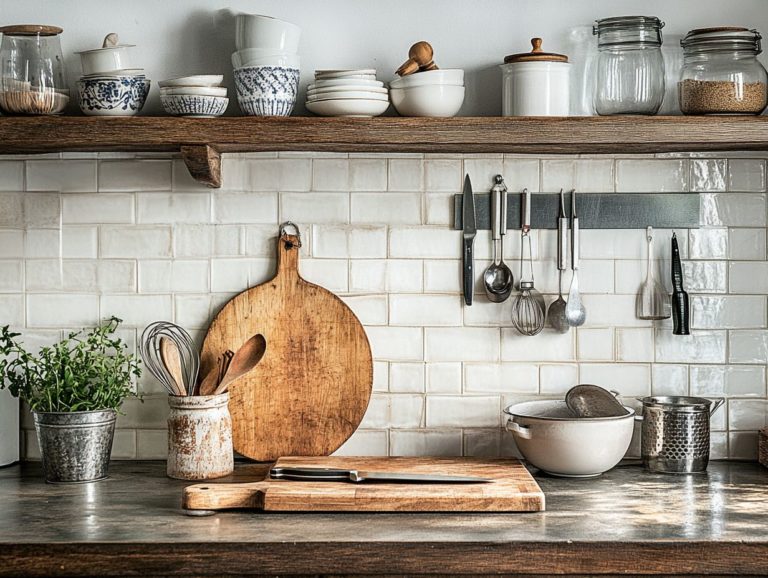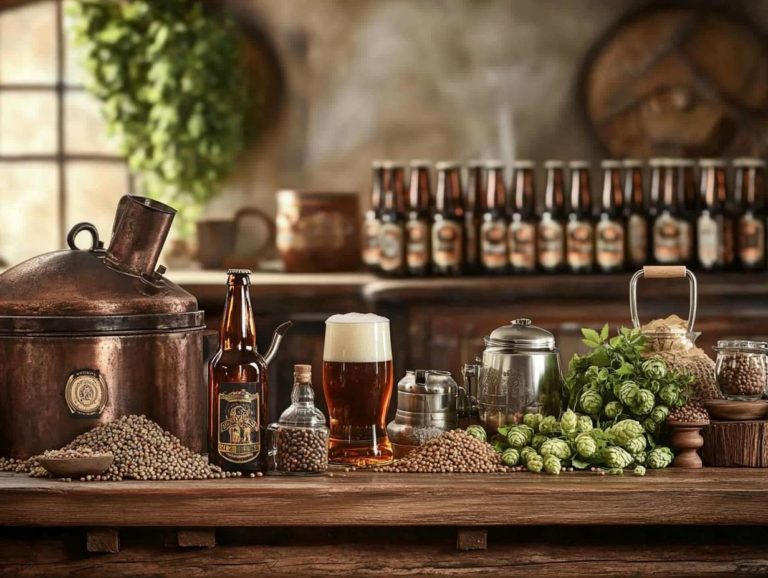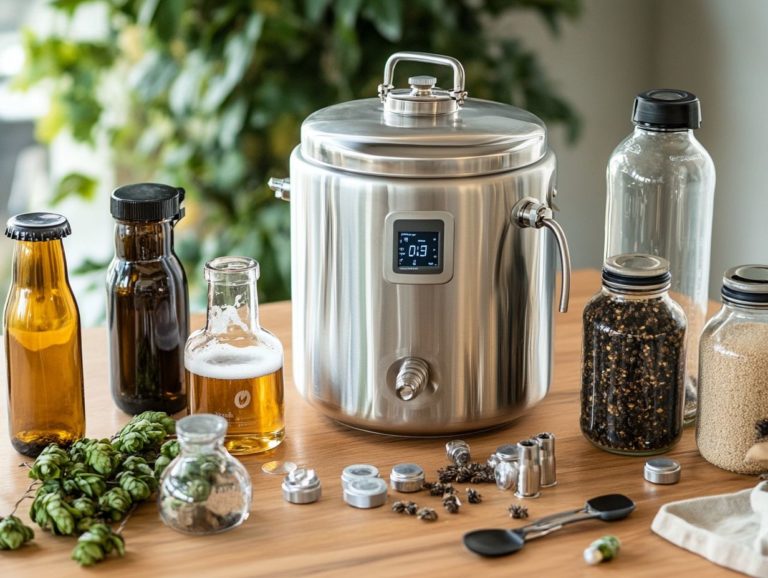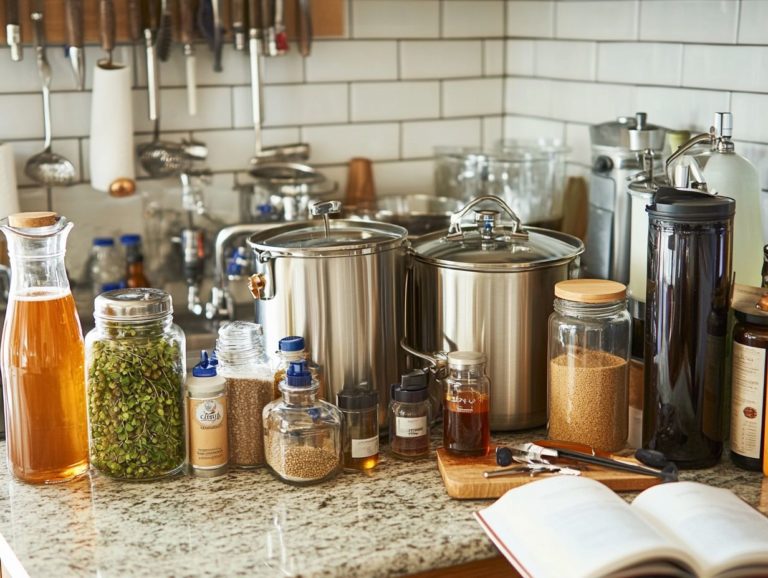Best Practices for Home Brewing Safety
Contents
- A Complete Guide to Home Brewing Safety
- Key Takeaways:
- Why Is Safety Important in Home Brewing?
- What Are the Risks Involved in Home Brewing?
- 2. Chemical Exposure
- 3. Fire Hazards
- How to Ensure Safety in Home Brewing?
- 1. Cleanliness and Sanitation
- What Are the Best Practices for Home Brewing Safety?
- Frequently Asked Questions
- What are some general best practices for home brewing safety and brewing precautions?
- How can I ensure my brewing equipment is safe to use for home brewing?
- Are there any potential brewing hazards to be aware of while home brewing?
- What should I do if I accidentally cut myself while home brewing?
- How can I prevent contamination during the brewing process?
- What are some common mistakes to avoid for home brewing safety and brewing guidelines?
A Complete Guide to Home Brewing Safety
Home brewing presents an exciting and rewarding opportunity for you to experiment with flavors and craft unique beverages tailored to your taste. Get ready to embark on an exhilarating journey of flavors and aromas in your home brewing adventure! Engaging in beer brewing allows you to explore traditional brewing techniques and methods, making each brewing experience unique.
However, safety should always be at the forefront of your mind. It s essential to be aware of potential risks such as contamination, chemical exposure, and fire hazards. Every brewer must understand these risks to ensure a safe brewing experience while maintaining the integrity of the beer.
This guide will walk you through vital safety measures, including the importance of cleanliness, proper equipment usage, and effective fire prevention strategies. These elements are crucial for safe home brewing.
By adhering to these best practices, you can fully enjoy the brewing process while minimizing risks and paving the way for a successful outcome in your homebrew endeavors.
Key Takeaways:
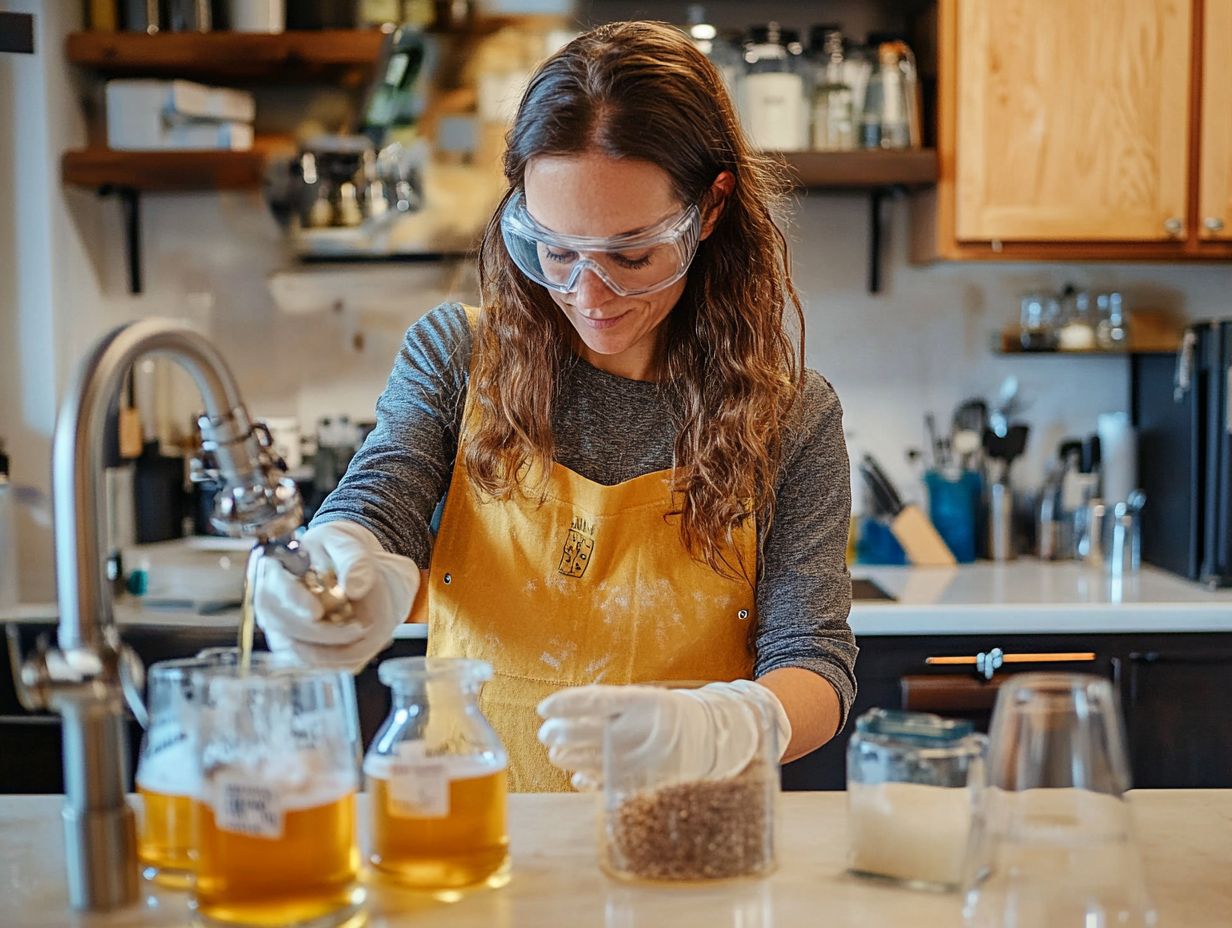
- Keep your home brewing area clean and sanitary to avoid contamination and ensure quality beer, following industry-standard brewing guidelines.
- Use proper equipment, such as brewing kits and fermentation vessels, and storage methods to prevent chemical exposure and fires.
- Educate yourself on home brewing safety measures, follow instructions and recipes, and keep records to ensure a successful and safe brewing process, minimizing homebrewing risks.
Why Is Safety Important in Home Brewing?
Safety is paramount in home brewing, encompassing important aspects that ensure not only a successful brewing experience but also your well-being and that of those around you.
By understanding brewing hazards and adopting safe brewing practices, you can significantly reduce the risks involved. Choosing the right brewing equipment also plays a crucial role in this equation.
The brewing community is rich with shared knowledge about brewing safety, highlighting the necessity of adhering to guidelines that guarantee quality beer while minimizing potential accidents related to fermentation, the process where yeast turns sugars into alcohol, and alcohol production. Prioritizing safety means you can enjoy the art of brewing with confidence and peace of mind.
What Are the Risks Involved in Home Brewing?
Home brewing is a delightful pursuit, but it carries unique risks that can impact both the quality of your beer and your safety as the brewer.
Contamination during fermentation, exposure to hazardous chemicals from brewing equipment, and potential fire hazards when using propane for heating are critical concerns that can lead to unfortunate mishaps.
Understanding these brewing risks is essential for anyone dedicated to crafting high-quality beer while ensuring a safe and enjoyable brewing experience.
1. Contamination
Contamination poses one of the most significant risks in home brewing, capable of compromising the quality of your beer and introducing undesirable flavors and aromas. Sources of contamination can stem from dirty brewing tools, improper sanitization techniques, and even airborne bacteria that might infiltrate during fermentation.
To ensure your home brewing is safe and successful, it’s crucial to understand the importance of thoroughly cleaning and sanitizing your equipment before and after each brewing session using appropriate cleaning supplies.
A range of factors can lead to contamination, including leftover residue from previous brews, unfiltered water, and even pests that may invade your brewing space. To mitigate these risks, adopt strict cleaning protocols using hot water and a suitable cleaning agent to eliminate all traces of dust and organic matter from your fermenters, bottles, and tubing.
Once you’ve cleaned your equipment, follow up with an effective sanitization routine. Products like Star San or bleach solutions will create an inhospitable environment for unwanted microorganisms. Practicing good hygiene, such as washing your hands thoroughly and minimizing the exposure of materials to open air, will further enhance brewing safety and help you produce high-quality beer.
2. Chemical Exposure
Chemical exposure is a significant risk in home brewing. Various chemicals used for cleaning and sanitizing equipment can pose health risks if not handled properly.
Common brewing chemicals include sodium metabisulfite and acid-based sanitizers such as Star San. Being aware of and adhering to brewing safety guidelines can substantially mitigate these risks and cultivate a safer brewing environment.
As a home brewer, it’s crucial to understand the types of chemicals you might encounter throughout the brewing process. For instance, caustic cleaners effectively remove organic residue but can be harmful if they come into contact with your skin or are inhaled. This highlights the importance of wearing protective gear.
Ensuring proper labeling and storage of these substances can help prevent accidental misuse. Familiarizing yourself with safety data sheets (SDS) (documents that provide information on the properties of hazardous substances) for each chemical you use is a wise move, as they provide crucial information about first aid measures and potential hazards.
Good ventilation is essential as it minimizes inhalation exposure and creates a safer atmosphere.
3. Fire Hazards
Fire hazards are a significant threat in home brewing. Proper management and storage of propane tanks are essential to prevent potential accidents.
To enhance your safety, always use propane appliances in well-ventilated areas to minimize the risk of gas accumulation. Regularly inspecting hoses, connections, and safety valves for leaks is crucial, as even small amounts of propane can lead to dangerous situations.
Having a fire extinguisher rated for flammable gases nearby can provide you with peace of mind. Familiarize yourself with local regulations regarding propane usage to ensure compliance while adopting best practices.
Take these precautions seriously! Doing so will ensure a safer brewing environment and enhance your enjoyment of the process.
How to Ensure Safety in Home Brewing?

Ensuring safety in home brewing requires a proactive approach. You should focus on every aspect of the brewing process, from selecting equipment to cleaning fermentation vessels.
By adhering to established brewing guidelines and embracing sound practices, you can enjoy a successful brewing experience while preserving the quality and integrity of your beer.
1. Cleanliness and Sanitation
Maintaining cleanliness and sanitation is crucial for safe home brewing. It directly influences the quality of your beer.
Effective sanitation of your brewing equipment, including fermentation vessels and utensils, is essential to prevent contamination and ensure a successful fermentation process. Adopt rigorous cleaning practices and utilize effective sanitizing equipment to safeguard your brewing efforts from potential pitfalls.
A clean brewing environment significantly reduces the risk of unwanted microorganisms that can spoil or alter the flavor of your final product. Start by thoroughly washing all your items with hot soapy water, then rinse them with clean water to eliminate any residues.
After that, reach for a sanitizing solution such as a no-rinse sanitizer to treat every surface that may come into contact with your beer. Don t overlook the areas where your brewing equipment is stored; dust and grime can harbor contaminants that you definitely want to avoid.
By prioritizing these cleaning and sanitizing practices, you can greatly enhance your chances of achieving the desired quality in your home-brewed creations.
2. Proper Equipment and Storage
Using the right equipment and ensuring proper storage is essential for maintaining safety in home brewing. As a home brewer, it’s wise to invest in high-quality brewing equipment, including fermentation vessels that are specifically designed for optimal processes. This not only mitigates risks associated with mishaps but also enhances your overall brewing experience.
By storing your ingredients and equipment away from hazardous materials, you contribute to a safer brewing environment. This ensures that you and your fellow enthusiasts can enjoy the fruits of your labor in quality beer.
It s equally important for you to focus on the cleanliness and maintenance of your tools. Any contamination can ruin your precious batches and pose health risks that are best avoided. When selecting your brewing supplies, consider the materials of your equipment. Stainless steel and food-grade plastic are generally the safest choices.
Proper storage practices, such as keeping your malt and hops in cool, dry places, will help preserve their freshness and flavor quality.
Mastering sanitization techniques is key to brewing success! Understanding the significance of these techniques, whether it involves using boiling water or specific cleaning solutions, prevents undesirable microbial growth. This knowledge contributes to a safe and successful brewing environment, allowing you to truly savor the fruits of your brewing endeavors.
3. Handling of Chemicals
Proper handling of chemicals is essential for ensuring safety in home brewing, especially when it comes to using sanitizing equipment and cleaning agents. Familiarize yourself with the chemicals at your disposal, such as sodium metabisulfite and acid-based sanitizers, and adhere to the recommended safety precautions to minimize exposure risks.
Awareness and education are crucial in promoting safe home brewing practices while maintaining the integrity of your brewing process.
As a brewer, you must understand the potential hazards associated with each chemical. This includes the importance of proper storage to prevent any accidental spills or reactions. Using personal protective equipment, such as gloves and goggles, significantly enhances your safety by creating a barrier against harmful substances.
Ensure adequate ventilation in your brewing space to help mitigate inhalation risks. Keeping a first-aid kit within easy reach is also a wise strategy. Educate everyone involved in the brewing process about emergency procedures related to chemical exposure. By engaging in these best practices, you cultivate a safer brewing environment that protects both you and the final product.
4. Fire Safety Precautions
Implementing fire safety precautions is absolutely essential for you as a home brewer, especially if you re using propane to heat during the brewing process. Ensuring proper ventilation, maintaining safe distances between heat sources and flammable materials, and mastering the art of handling propane tanks can dramatically reduce fire hazards. Staying informed about fire safety practices is vital for creating a secure home brewing environment.
By conducting thorough risk assessments and regularly checking all your equipment, you can spot potential hazards before they escalate into dangerous situations. Using brewing-specific equipment, such as heat shields and flame arresters, will further bolster your safety measures.
Always keep a fire extinguisher handy, ensuring it’s suitable for chemical fires, including those involving propane. It s also prudent to familiarize yourself with local regulations and ordinances related to safe brewing practices. Simple actions, like keeping your brewing area uncluttered and free of loose materials, can make a significant difference in mitigating the risks associated with brewing and propane use.
What Are the Best Practices for Home Brewing Safety?
Adopting best practices for home brewing safety is essential for ensuring your brewing experience is both successful and enjoyable. By adhering to established brewing guidelines and tapping into the wealth of knowledge within the brewing community, you can expertly navigate potential risks while crafting quality beer consistently.
Grasping the fundamentals of brewing techniques, ingredient selection, and the fermentation process will not only enhance your safety but also elevate your overall enjoyment of home brewing.
Now that you know these safety practices, it s time to put them into action and enjoy brewing your own quality beer!
1. Educate Yourself
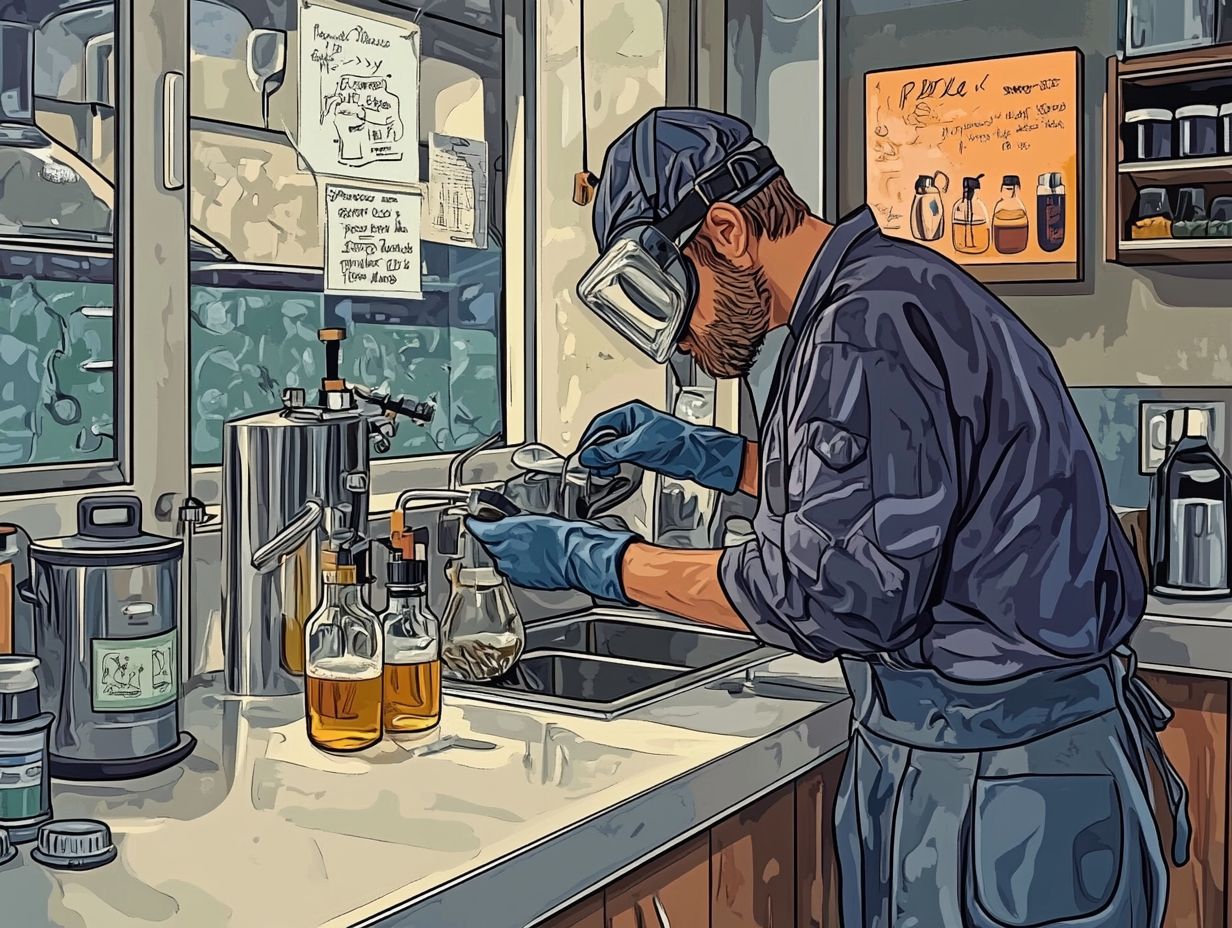
Education is a cornerstone of safe home brewing. As a well-informed brewer, you are better equipped to navigate the brewing process.
Engaging with the brewing community, attending workshops, and accessing high-quality resources can significantly elevate your understanding of brewing techniques and safety practices.
When you grasp the fermentation process, brewing chemistry, and potential hazards, you’ll be able to produce exceptional beer while minimizing risks.
By exploring online courses, forums, and books authored by seasoned brewers, you can acquire essential practices that enhance safety and efficiency in your brewing endeavors.
Joining local homebrew clubs cultivates camaraderie and offers invaluable insights through shared experiences and expert guidance.
Many breweries even provide classes focused on responsible brewing, giving you the chance to deepen your knowledge while adhering to safety protocols.
These resources empower you to hone your craft safely, ensuring that your brewing experiences are enjoyable and successful for both you and your guests.
2. Follow Instructions and Recipes
Following instructions and recipes is crucial for achieving consistent results in home brewing. Any deviation could lead to brewing mishaps and compromise the quality of your beer.
As a home brewer, you should meticulously adhere to your brewing recipes. Make sure you fully understand each step of the brewing process, from ingredient selection to managing your fermentation vessel.
While creativity plays a vital role in brewing, even the tiniest mistakes can result in off-flavors or undesirable characteristics in your final product.
For example, neglecting precise measurements of hops may leave you with brews that are overly bitter. Variations in fermentation temperature can create inconsistent flavors.
Inaccurate water chemistry can significantly impact the overall taste and mouthfeel of your beer.
By steering clear of common pitfalls, you re setting the stage for enjoyable and satisfying creations.
Each batch can reflect the rich traditions and complexities of quality brewing.
3. Use Quality Ingredients
Quality ingredients are the secret to brewing outstanding beer at home. The choice of grains, hops, yeast, and water directly influences the final product. It s essential to prioritize sourcing fresh and high-quality ingredients.
This attention to detail is fundamental to your brewing methods and plays a significant role in shaping the overall flavor profile of your beer.
Engaging with the brewing community can also be invaluable. It opens doors to recommendations for trusted suppliers and insider tips on ingredient selection.
To ensure the grains you choose provide the desired character, it’s wise to opt for local or specialized malt houses, where freshness is more likely guaranteed.
In terms of hops, select them based on their aromatic qualities and the specific style you re brewing. Don’t forget to check the harvest date to ensure optimal strength.
As for yeast, understanding the fermentation profile of the strain you re using can significantly impact the outcome of your beer. It s crucial to work with healthy, viable cultures.
Let s not overlook the importance of clean, pure water often the unsung hero of the brewing process. A bit of thorough testing and treatment can go a long way in ensuring your beer turns out just right.
4. Monitor Temperature and Time
Monitoring temperature and time is crucial in brewing. Reliable thermometers and timers let you track brewing conditions accurately. Deviations can lead to less-than-ideal fermentation outcomes, affecting your beer’s overall quality.
By following best practices for temperature ranges and timing, you’ll unlock the secret to brewing perfection. Utilizing digital thermometers provides precise readings, giving you greater control over mash temperatures and fermentation phases.
A brewing timer ensures each step, from mashing to hopping, is executed within the recommended time frames. Understanding yeast temperature preferences is beneficial, as many yeast strains thrive within specific ranges, profoundly influencing fermentation.
Regularly checking the temperature of your fermentation chamber helps maintain an optimal environment, promoting healthy yeast activity. By combining these best practices, you can optimize both flavor development and overall beer quality, making your brewing experience enjoyable.
5. Keep Records
Keeping detailed records improves your future brews. Note down ingredient quantities, temperatures, and fermentation times. This documentation allows you to analyze your brewing practices and make informed adjustments over time.
Engaging with the brewing community can elevate this experience; sharing insights can lead to valuable improvements.
Tracking variables such as pH levels, carbonation methods, and the storage conditions of your finished product provides a deeper understanding of how different factors influence the final outcome.
By cataloging these observations, you refine your brewing techniques and contribute to the collective knowledge of fellow enthusiasts. This dialogue within the brewing community can inspire creativity, leading to innovative approaches and exceptional craft beers.
Frequently Asked Questions
What are some general best practices for home brewing safety and brewing precautions?
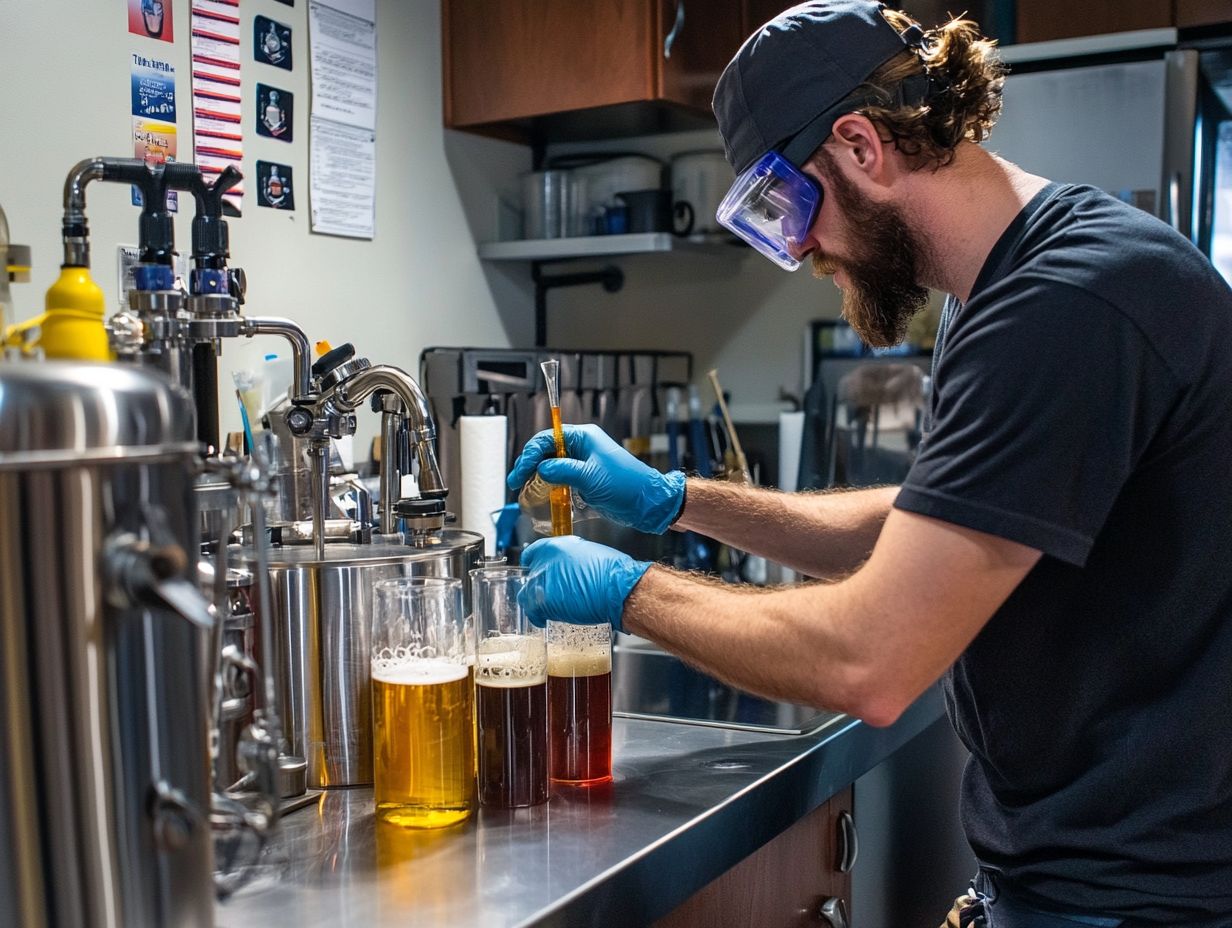
Key best practices for home brewing safety include following proper sanitation techniques for cleaning and sanitizing equipment, wearing protective gear such as gloves and safety glasses, and maintaining a clean work area to prevent contamination. These guidelines help ensure a safe home brew.
How can I ensure my brewing equipment is safe to use for home brewing?
Before using any brewing equipment, clean and sanitize it thoroughly. This includes all tools, containers, and fermentation vessels. Proper cleaning is crucial for maintaining beer quality and integrity during fermentation.
Are there any potential brewing hazards to be aware of while home brewing?
Yes, be aware of potential hazards such as hot liquids and steam, sharp tools, and chemicals like cleaning agents and sanitizers such as Star San and Iodophor. It s important to handle these items carefully to avoid mishaps and ensure safe brewing practices.
What should I do if I accidentally cut myself while home brewing?
First, stop the bleeding by applying pressure with a clean cloth. Then, sanitize the area and cover it with a bandage. Seek medical attention if the cut is deep or does not stop bleeding. This is part of general brewing safety practices.
We invite you to share your brewing experiences or ask any questions you may have!
How can I prevent contamination during the brewing process?
To prevent contamination, keep your work area clean and organized. Use separate tools and equipment for different steps of the brewing process.
Always clean and disinfect them before use. Avoid touching equipment with bare hands to ensure the alcohol production process remains uncontaminated, thereby maintaining beer quality.
What are some common mistakes to avoid for home brewing safety and brewing guidelines?
Some common mistakes include not properly cleaning and sanitizing equipment, failing to follow proper measurements and instructions, and neglecting protective gear. Always be cautious when working with hot liquids and chemicals during beer fermentation.
Exposure to carbon dioxide can be hazardous, so take necessary precautions. Adhering to brewing standards is essential for a quality beer brewing experience.

